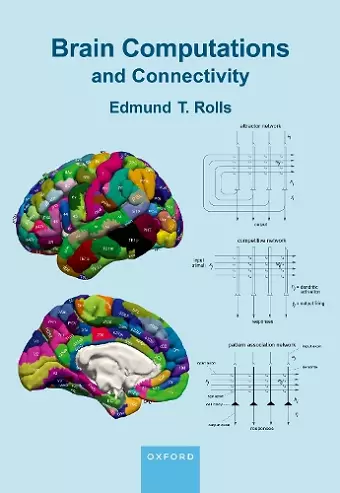Brain Computations and Connectivity
Format:Hardback
Publisher:Oxford University Press
Published:11th Jul '23
Currently unavailable, and unfortunately no date known when it will be back

This is an open access title available under the terms of a CC BY-NC-ND 4.0 International licence. It is free to read on the Oxford Academic platform and offered as a free PDF download from OUP and selected open access locations. Brain Computations and Connectivity is about how the brain works. In order to understand this, it is essential to know what is computed by different brain systems; and how the computations are performed. The aim of this book is to elucidate what is computed in different brain systems; and to describe current biologically plausible computational approaches and models of how each of these brain systems computes. Understanding the brain in this way has enormous potential for understanding ourselves better in health and in disease. Potential applications of this understanding are to the treatment of the brain in disease; and to artificial intelligence which will benefit from knowledge of how the brain performs many of its extraordinarily impressive functions. This book is pioneering in taking this approach to brain function: to consider what is computed by many of our brain systems; and how it is computed, and updates by much new evidence including the connectivity of the human brain the earlier book: Rolls (2021) Brain Computations: What and How, Oxford University Press. Brain Computations and Connectivity will be of interest to all scientists interested in brain function and how the brain works, whether they are from neuroscience, or from medical sciences including neurology and psychiatry, or from the area of computational science including machine learning and artificial intelligence, or from areas such as theoretical physics.
This neuronal network approach stands in contrast to connectionist approaches and also focuses exclusively on higher primate and human modeling. Helpful chapter highlights and several practical appendixes are provided, and the bibliography is excellent. * H. Storl, Augustana College (IL), CHOICE *
This "bottom-up" approach to data-driven neuroscientific discovery serves as the perfect primer for those who study brain sciences, cognitive sciences, artificial intelligence, neuro-engineering, neuropsychology, and empirically oriented philosophy. * H. Storl, CHOICE *
Brain Computations is the first complete attempt to summarize our current knowledge about computation in the brain, at a level a graduate can understand. ... This is a biologically grounded, full systems neuroscience textbook-which makes it one of a kind. ... Hippocampal memories, action selection in the striatum, orbitofrontal reward representations, emotion in the limbic system, cerebellar motor control, parietal spatial coordinate transforms, place fields, and posterior visual object recognition-all these can emerge from relatively simple rules. This is Rolls' unspoken but substantial grand unifying theory. (full review https://doi.org/10.1093/brain/awab477) * Brain *
He concludes with 13 principles about how information in encoded in neural networks. This is almost the Holy Grail of neuroscience, the language of neurons, what makes us what we are. Yet, these ideas are presented in a simple unassuming scientific language ... * Nikolaos C. Aggelopoulos, Neurosurgery *
ISBN: 9780198887911
Dimensions: 252mm x 175mm x 46mm
Weight: 1804g
1174 pages
2nd Revised edition